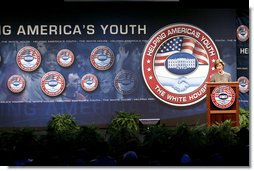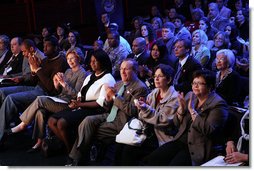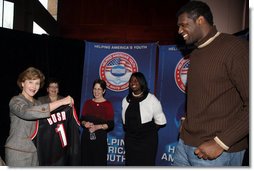|
Home >
News & Policies >
February 2008
|
For Immediate Release
Office of the First Lady
February 28, 2008
Mrs. Bush's Remarks at the 6th Regional Conference on Helping America's Youth
Portland Center for the Performing Arts
Portland, Oregon
8:55 A.M. PST
MRS. BUSH: Thank you all. Thank you, Greg. Thank you very much, Greg. Thanks, everybody. Greg's story is a perfect example of why we are all here today, and that is to remind every caring adult that they can make a huge difference in the lives of young people. If children know that we believe in them, then they're much more likely to believe in themselves. And Greg has the story of several adults who were able to step in and help him at different points of his life. Thank you very much, Greg.
 I also want to thank the Trail Blazers Coach Nate McMillan -- and everyone
in your organization -- for rising to the challenge of serving your
community, and for showing what it really means to "give an assist."
(Laughter.)
I also want to thank the Trail Blazers Coach Nate McMillan -- and everyone
in your organization -- for rising to the challenge of serving your
community, and for showing what it really means to "give an assist."
(Laughter.)
The Trail Blazers have filled many needs for children in Portland: at the Blazers Boys and Girls Club, donating books and reading to children, working in classrooms, mentoring, and answering the call to play ball on better courts at school. I don't know of any other team in the NBA that's renovated the basketball courts at every high school in town. Isn't that terrific? (Applause.)
Governor Kulongoski, thank you so much for sharing your story with us. It's also a great reminder for all of us that children can beat the odds and better their lives if a caring adult is willing to reach out and say, "I believe in you."
And I want to also thank Mary Oberst, who is here with us today, the First Lady of Oregon. Thank you so much for joining us, Mary. Robyn Williams is the Executive Director of the Portland Center for the Performing Arts. Robyn, thank you very much. This is a beautiful site for this conference. Also John Walters is with us. He's the Director of the White House Office of National Drug Control Policy. Thank you very much, John, and you'll be hearing from him later, I think.
I'm very happy to be here in Portland today with all of these distinguished community leaders for our 6th Regional Conference on Helping America's Youth. The work that you do in your neighborhoods -- helping young people build the knowledge and the self-respect they need to lead successful lives -- is at the heart of Helping America's Youth. President Bush announced the Helping America's Youth initiative in his 2005 State of the Union address, and he asked me to lead it. So over the last two and a half years, I've traveled throughout the United States, visiting with young people and with the adults who are so important to their lives. I've been to schools and to after-school programs. I've met with mentors and Big Brothers and Big Sisters. I've visited sports programs -- one in Detroit, a debate program in Atlanta, and gang-intervention programs in Los Angeles and Chicago.
All of these visits led to the White House Conference on Helping America's Youth in October 2005, and then to regional conferences in Indianapolis, Denver, Nashville, St. Paul, Dallas, and now here in Portland.
 At the White House Conference, we introduced an online, interactive
Community Guide, which helps concerned adults learn more about their own
communities. And yesterday I think about 140 of you were here to learn how
to -- all the people who are parts of community coalitions -- to learn how
to use this Guide, and I urge all of you, when you go back home, to look at
it and use it.
At the White House Conference, we introduced an online, interactive
Community Guide, which helps concerned adults learn more about their own
communities. And yesterday I think about 140 of you were here to learn how
to -- all the people who are parts of community coalitions -- to learn how
to use this Guide, and I urge all of you, when you go back home, to look at
it and use it.
If local law enforcement, for instance, has mapped your community's crime statistics, the Guide will show you which neighborhoods have the most youth-related problems, and then what local resources you already have to address these problems. And an interactive map on the Guide lets users enter their own zip codes, and then find demographic data about young people in your own neighborhoods. And then you can locate the federally supported youth programs nearby. The Guide's Program Tool helps adults find youth initiatives that research has proven are effective in reducing substance abuse, gang activity, and other risk factors faced by young people in your community.
The Community Guide is available on the Helping America's Youth website at www.helpingamericasyouth.gov -- that's g-o-v. The site also features live and archived conference webcasts, which gives me the chance right now to say hello to everyone who's watching this conference live via the web.
The Community Guide will evolve into a new federal website now, thanks to an executive order that the President signed earlier this month. The Guide was devised by a working group from nine different federal agencies. Every agency that has youth-serving programs in it, like the one the Governor mentioned, Department of Defense program, the National Guard program that he accepted the award for Oregon from yesterday -- that's an example of one of the DOD programs. There are also, obviously, youth-serving programs in Health and Human Services, Department of Ag, and many other agencies.
And so over the last three years, we've had a working group representing each one of these agencies working together to develop this Guide. They're letting us know where we've fallen down, what issues we're not addressing with federal programs. And then they're also -- we're finding out where we're overlapping and ways we can be more effective by working together.
 This new site that they've been working on will serve as a central
information source for communities to develop their own plans for their own
young people. The President's executive order also gives direction to the
agencies and organizations that have generated so much momentum for Helping
America's Youth over the past three years. President Bush and I want to
make sure that all the terrific work that's been done by this working group
and all of these federal agencies and their partners will continue.
This new site that they've been working on will serve as a central
information source for communities to develop their own plans for their own
young people. The President's executive order also gives direction to the
agencies and organizations that have generated so much momentum for Helping
America's Youth over the past three years. President Bush and I want to
make sure that all the terrific work that's been done by this working group
and all of these federal agencies and their partners will continue.
This summer, we added a new feature to the Community Guide: the Helping America's Youth News Flash. This e-newsletter provides updates on recent Helping America's Youth events, and showcases successful community programs, and it highlights adults who've shown exceptional dedication to young people. If you know of an outstanding community coalition or a caring adult who should be featured in the News Flash, please email comments@helpingamericasyouth.gov.
Through the Community Guide, and through all of these regional conferences, we're working to make Helping America's Youth more local so that we can work directly with community leaders to address the unique challenges facing young people in their communities. And the challenges that face young people today are far greater than they were just a generation ago. Drugs and gangs, predators on the Internet, violence on television and in real life, are just some of the negative influences present everywhere across our country. And as children face these dangers, they often have fewer people to turn to for help. More children are raised in single-parent families -- most often without a father. Millions of children have one or both of their parents in prison. Many boys and girls spend more time alone or with their peers than they do with any member of their family.
Today we're learning about the difficulties facing children and teens here on the West Coast. Gang violence is one of these challenges. In 2005, I visited CeaseFire Chicago, now called CeaseFire Illinois, and saw how this program has revolutionized the city's approach to eradicating youth violence. Instead of relying only on law enforcement, CeaseFire mobilizes whole communities to address the conditions that lead to violence and shootings. CeaseFire sends Outreach Workers, often former gang members themselves, on to Chicago's streets, where they teach young people who've grown inured to violence what normal standards of behavior are. The program's founder, Dr. Gary Slutkin, explains that CeaseFire Outreach Workers are, and I quote, "followed around like Pied Pipers," because these kids are so hungry for a good example.
 CeaseFire encourages adults, especially the clergy, to serve as role
models, and encourages young gang members to get and keep legitimate jobs.
CeaseFire's model is so successful that cities around the country are now
adapting it to their own communities, and I think there is one here in
Portland as well.
CeaseFire encourages adults, especially the clergy, to serve as role
models, and encourages young gang members to get and keep legitimate jobs.
CeaseFire's model is so successful that cities around the country are now
adapting it to their own communities, and I think there is one here in
Portland as well.
The problems confronting youth, and the threats posed by gangs, are among the many great challenges facing America's young people, but greater still is our love for our children, our hope for them, and the dedication of millions of Americans to helping young people succeed.
To make sure every child is surrounded by positive influences, even more adults must dedicate themselves to Helping America's Youth. Adults should be aware of the challenges that face children, and they should take an active interest in their lives. Adults, and especially parents, should build relationships where they teach their kids healthy behaviors by their own good examples.
Across our country, I've seen how adults from every part of the community can make a difference in the lives of young people. I met Duncan Campbell, founder of Friends of the Children, right here in Portland. His organization pays mentorships to men and women who make the extraordinary commitment to be involved in a child's life for 12 years -- during their entire school years. Is Duncan Campbell here? I think he's going to be here later today.
I also met Dr. Ken Canfield, who founded the National Center for Fathering. When I visited the Center in Kansas City, I saw how it helps fathers develop emotional bonds with their children. When a father reads with his son or daughter, or just talks about his child's day, that child feels like the most important person in the world. Sometimes showing fatherly affection doesn't take all that much time. One of my favorite parts that I think you saw in the video was watching the fathers and their children with their 15-count hug. Over time, a 15-count hug can give children a sense of security and love that never goes away.
At Think Detroit, volunteers in the city's Police Athletic League help young people build character and develop healthy behaviors through sports. I met one little boy there in 2005, and I still remember what he said in response to a reporter's question about my visit. The little boy said, "I wish she could stay here."
Young people want us in their lives, and they need us in their lives. And each of us has the power to step in somewhere and help a young person.
Governor and Mrs. Kulongoski, thank you very much for being here today with us. Thank you to Greg Oden and to the Trail Blazers. And thanks to each and every one of you for the great work you do every day to help America's youth.
Thank you all very much. (Applause.)
END 9:08 A.M. PST


